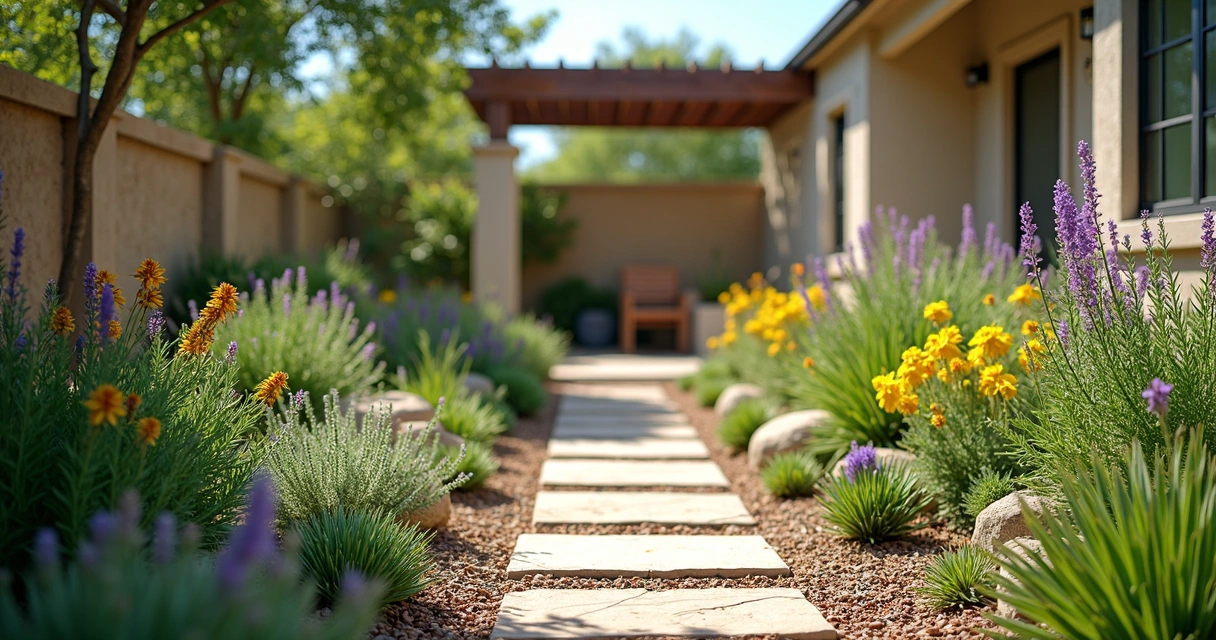There are days in Central Texas when the sky holds its breath for weeks. The sun feels unyielding. Lawns fade, but certain plants manage to thrive—almost as if they’ve adapted to this drama. If you’re hoping for a yard that’s both lush and low-maintenance, choosing water-wise plants isn’t just clever, it’s necessary. Urban Oasis has seen firsthand how thoughtfully selected drought-resistant species can turn even the driest patch into a welcoming, green retreat.
Here’s a story that might sound familiar: A couple once called us, tired of their brittle St. Augustine lawn and wasted irrigation. They wanted a landscape that needed less water—without looking bare or bland. I remember how skeptical they were that their home could look good without weekly soaking. But six months after planting native perennials, their yard was the most inviting on the block. It helped lower their water bill too.
But choosing the right drought-tolerant plants for Texas isn’t just about saving water. It’s about respecting this place. It’s about supporting pollinators and wildlife. And, sure, it’s also about enjoying your mornings outside, worry-free.
 Why it matters: water, savings, and style
Why it matters: water, savings, and style
If you care about saving water—well, you’re not alone. According to a study by the Texas Water Resources Institute, nearly one-third of household water is used outdoors, mostly for landscaping. Yet, many common ornamental plants don’t just “survive” dry spells—they struggle.
Plants don’t have to be thirsty to be beautiful.
With Texas summers growing longer and rainfall uncertain, sustainable landscaping is a smart move. Using native plants from Austin and nearby areas means less irrigation, less fuss, and more resilience. This approach is at the heart of what Urban Oasis offers clients—efficient, stylish yards perfectly adapted to local weather.
Choosing the right plants for Central Texas
Not every plant listed as “drought-tolerant” will suit our tough soils or prairie winds. True success starts with species proven to thrive in local conditions. Below are top choices for water-wise gardens and a few cautionary notes on what to avoid.
Central Texas standouts
- Mountain Laurel (Sophora secundiflora): Praised by the Central Texas Gardener, this small evergreen tree handles even tough drought years. Its fragrant purple blooms every spring are legendary. Needs only minimal watering and some sun. Great for structure and scent.
- Red Yucca (Hesperaloe parviflora): Despite the name, not technically a yucca. But as xeriscaping guides note, this rugged perennial blooms with coral-red spikes and barely needs extra water once rooted. Hummingbirds love it.
- Mealy Blue Sage (Salvia farinacea): Native to Austin and surrounding areas, this plant offers delicate blue blooms all summer. It thrives with little irrigation and attracts bees and butterflies.
- Engelmann’s Daisy (Engelmannia peristenia): Endorsed by the Native Plant Society of Texas, this cheerful yellow wildflower fits perfectly in sunny beds. Very little water needed, long blooming season, and a favorite for pollinators.
- Texas Sage (Leucophyllum frutescens): A classic in sustainable landscaping, with silvery foliage and purple flowers that appear after every rain. Rarely needs irrigation beyond what nature offers.
- Yaupon Holly (Ilex vomitoria): If you need a shrub for privacy, this native works well. It’s attractive year-round and its berries support local wildlife.
- Bamboo Muhly (Muhlenbergia dumosa): Airy, grasslike and great for adding texture to xeric gardens. Does very well with infrequent watering once established.
What not to plant
Many newcomers or even some long-time gardeners might try exotic plants that promise “green all summer”—but don’t last through a true Texas drought. Worse, a few are actually illegal. In fact, according to Homes & Gardens, invasive species such as Purple Loosestrife, Kudzu Vine, Salt Cedar, Chinese Tallow, and Brazilian Peppertree are not just a problem for your garden—they harm local wildlife and natural spaces. Always check the proven native and non-invasive options instead of these risky imports. The Native Plant Society of Texas maintains an extensive, trustworthy list.
Combining beauty and resilience
Maybe “drought-tolerant” sounds dusty or dull. But every time I see a mature Red Yucca blazing with red tips in July, or a Mountain Laurel perfuming a breezy corner, I’m reminded this style can be anything but dry. Clever combinations—mixing evergreens, perennials, and bold-textured grasses—give you year-long interest.

How to make drought-resistance work for you
A successful water-wise garden relies on more than just the plants—you also need good practices.
- Group by water needs: Place thirstier species near shaded areas or downspouts, and use the driest spots for succulents, sage, or yucca.
- Soil preparation: Improve clay-heavy soils with compost and ensure drainage—the root zone is where drought-busters develop strength.
- Mulch: Keep bare ground covered with mulch, slowing evaporation and stopping weeds from stealing moisture.
- Water deeply, less often: It encourages deep roots. For new plants, establish with regular, slow watering, then cut back gradually.
For a tailored approach, Urban Oasis always reviews site exposure, soil, and the client’s maintenance style (and level of patience!). Seasonal adjustments are often needed, as you can see from our tips for year-round landscape success.
Small choices, big impact
Filling your landscape with native plants from Austin and Central Texas isn’t just the safer route—it’s a quiet, ongoing gift to the neighborhood. You can have pollinators, cooler evenings, and a yard that keeps looking better, even during water limits. If you’re curious about which plants work with cold dips as well, check our list of cold-hardy plants for Texas. And for even broader ideas, you’ll find more under sustainable landscaping guides.
Conclusion
Central Texas doesn’t have to mean brown turf and empty beds. With careful plant selection, your landscape can thrive on little water—and look good doing it. Urban Oasis specializes in making these choices easy and stylish, transforming yards across Austin into lush, low-water sanctuaries.Now’s a good time to start dreaming. If you want expert guidance on the best drought-tolerant plants and the smartest ways to design your outdoor space, reach out to Urban Oasis and let’s create a greener future together.
Frequently asked questions
What are the best drought-tolerant plants for Texas?
The top plants proven for dry Central Texas gardens include Mountain Laurel, Red Yucca, Mealy Blue Sage, Engelmann’s Daisy, Texas Sage, Yaupon Holly, and Bamboo Muhly. These species are tough, attractive, and need little supplemental water once rooted. Focusing on native selections is usually the wisest bet for both resilience and support of local wildlife.
How do I care for drought-resistant plants?
For best results, group plants by their water needs, amend the soil for drainage, use mulch generously, and water deeply but not often. At first, new plants need regular watering while roots develop. Once mature, cut back and only water during prolonged droughts. Occasional pruning and seasonal checks for pests or disease will help keep everything healthy.
Are native Texas plants better for dry areas?
Yes, native Texas plants are typically the right choice for dry spots. They’ve evolved to handle local weather, pests, and soils, which means less watering and effort from you. Plus, they help support pollinators and birds. Avoid invasive species, which can be illegal or damaging—see resources like the Native Plant Society of Texas for safe options.
Where can I buy drought-tolerant plants locally?
Local nurseries (especially those that focus on native species), botanical gardens, or farmers’ markets often carry a great selection. For more guidance, check online the plant categories at Urban Oasis’s recommended plants or connect with organizations such as the Native Plant Society of Texas for specialty lists and sources in your area.
Do drought-tolerant plants need any watering?
Almost all plants, even drought-hardy ones, need regular watering when first planted. This helps roots get established, which is key. Once matured and settled, many—like those in the Texas Water Resources Institute study—can persist with only rainfall in average years. During unusually long dry spells, though, an extra soak every few weeks will help them stay strong.


 Why it matters: water, savings, and style
Why it matters: water, savings, and style

